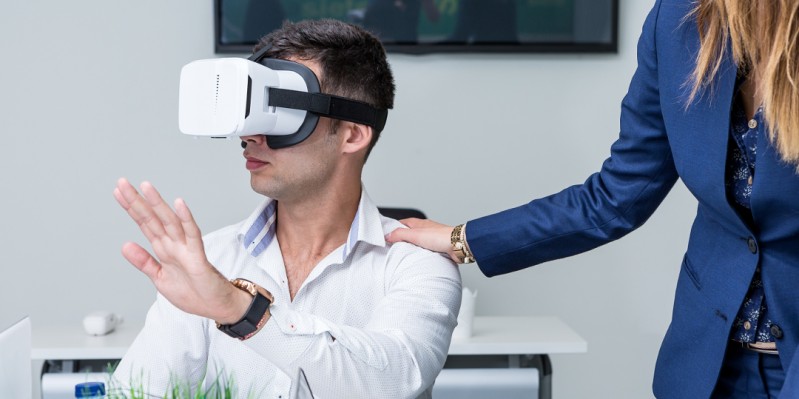I recently attended the Learning Technologies show, and one of the most useful seminars I saw was called “Does VR training really work?” It confirmed my thinking about what constitutes a truly useful application of VR in learning, rather than just a fad or an ego project. We’ve taken a look at the new dimensions VR can open, and some of the ways in which it might be overly hyped. But what exactly are the training scenarios it fits best? VR could be either the greatest learning asset, or a huge waste of money, depending on your VR learning needs.
VR has been getting massive attention in every field, with learning and development being no exception. Even back when it was still in its formative stages, before VR devices were publicly usable, everyone imagined the training potential. Clearly, simulations are immersive and make learning transfer and application more easily achievable. And what can take simulations to another level entirely? VR.
The latest pedagogical panacea, it got people thinking “oh boy, we can use VR in our company for all kinds of training courses! It will be fun, easy, and time efficient – not to mention our people will be engaged and L&D will be noticed in the company… and I’ll get a seat on the Board!” You get the drift.
When is VR training redundant?
Examples such as this surgical simulation training and aviation simulation training, the kind of learning that definitely needs to be done in a free-to-fail environment, are perfect for VR. It can give them add an unprecedented level of realism without real life consequences, and aids practice and learning by doing. But it can also add a level of emotional and sensory connection to training, such as being onboarded in a new workplace before arrival. It allows an individual to get comfortable and familiar with their new environment, practice their first 30 days, and shorten time to competence with processes and procedures.
However, there are some situations where the use of VR just amounts to overkill (especially if you are on a budget). In these cases, an alternative digital experience or video-based simulation might be cheaper and more effective than VR.
Think about examples such as when:
- You want your employees to learn how to use a specific software or desktop system (point-of-need learning can’t be beaten for this requirement)
- You have to present your employees with certain rules or guidelines to follow, such as for regulatory compliance
- You need real human interactions through blended or face-to-face training to improve interpersonal skills such as negotiation or customer support
Health and safety training, you would think, would generally be a great topic for VR. But the example shown below is in my opinion a waste of VR’s potential.
Now, just a caveat. I’m not having a go at the creators of this training. It looks pretty nice, but the learning design doesn’t make the most of the medium, does it? I’d be interested in hearing your views, so please do comment, but here’s what I think.
Let’s start with the “Unmanned reception”. Now sure, it’s exciting to have a virtual version, but does a VR experience convey the risks better than a still or video?
Next, we have the “Spilled liquid on the floor”. This would be great if the experience felt like you were slipping, but then here comes one of the practical downfalls of VR – that would not be palatable for everyone from a cognitive functionality perspective.
Next is the “Broken smoke detector.” We don’t know how to tell if it’s broken, or who to report it to. Again, probably not terribly useful to an employee.
Getting physical
It’s not just the financial investment in VR that needs to be considered, but also the time and physical investment by the learner. I’m a technology lover and games fanatic, and I have played some great stuff on VR, but after even 10 minutes, it can get a bit annoying or even disorientating. For longer simulations, continued practise, or dense subject matter, it’s just not the most practical medium with which to learn.
As much as VR gives you some amazing experiences, it still has its problems, even at the most basic user experience level. Quality-wise it still also has some way to go, and especially at cheaper price ranges, the headset might be quite uncomfortable to wear. If the controls are sticks that you have to use for moving, grabbing, writing or whatever function you are trying to accomplish, that adds another layer of physical effort and co-ordination, so it won’t be accessible for all learners. Imagine onboarding a group of 10 new starters using VR, all of them running around the office with goggles on looking for spilled water. Ironic that a health and safety course could actually be rather unsafe!
The true potential
VR is truly a great tool, with the capability to animate experiences that otherwise might require a great deal of effort. It can be a complete game changer, and integrated with gamification, it can make learning truly enjoyable for the majority of people.
However, Learning and development departments need to be careful not to rush head on into what could be an unnecessary investment with minimal return.
On the other hand, think about how VR could bring sectors traditionally resistant to digital learning into the fold. Medical students, firefighters, engineers, and all sorts of technicians being some of these. VR could be a vital disruptor in these industries where actually training the person without VR requires a lot more time, manpower and, higher cost. In this case, VR could literally be a life saver.





